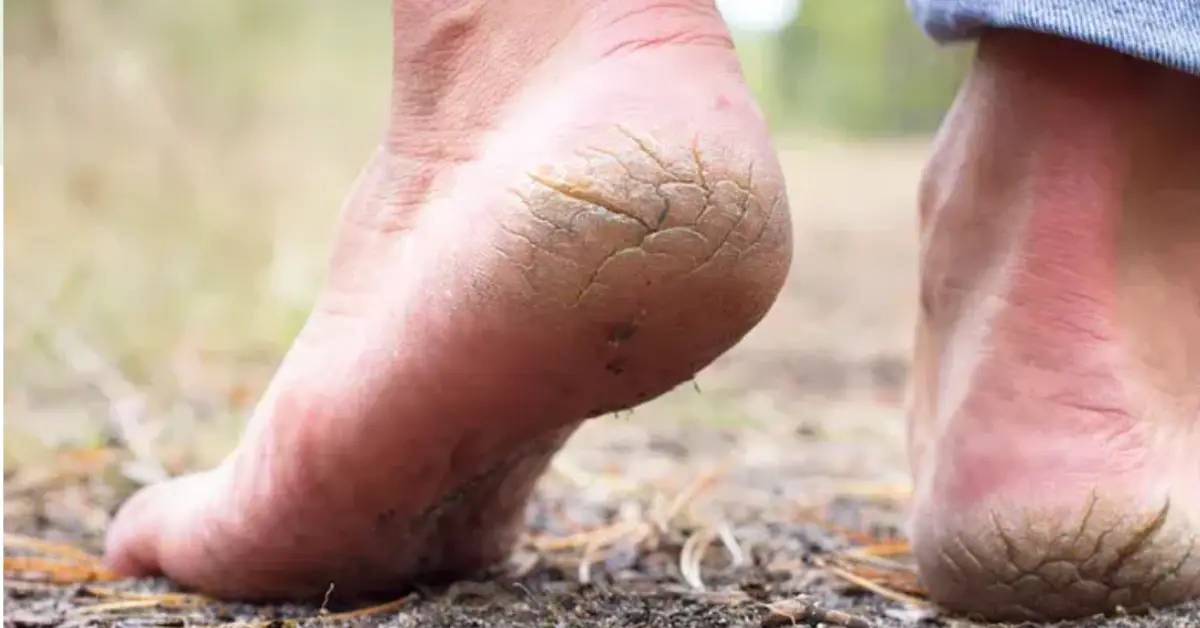A skin fissure is a crack in the epidermis, the outermost layer of skin which protects the body. It is often caused by excessively dry and sometimes thickened skin, especially on the bottom of the heels.
In addition to being uncomfortable, fissures can lead to skin ulcers, so it is important to treat them before they worsen. Often moisturising the skin may be sufficient for the cracks to heal.
Your doctor or other professional healthcare adviser may prescribe different treatment techniques depending on whether the fissures are shallow or deep.
Skin fissures can occur anywhere on the body, but most commonly occur on the fingertips, between the toes or fingers, on the heels of the feet and on other areas of your body that may be prone to dryness.
The visible signs of skin fissures include breaks in the skin that look similar to cuts or cracks, thickened or calloused skin around the fissure, dry skin in the surrounding area and in some cases bleeding.
Skin fissures can cause pain because of the cut in the skin. Additionally, irritants can enter the fissure causing more discomfort.
Skin fissures can be either superficial or deep. Superficial fissures are small cracks that do not penetrate the deeper layers of the skin, while deep fissures do penetrate the deeper layers.
Causes
Skin fissures develop as part of a progression of symptoms. At first, the skin becomes dry. It then thickens and may become discoloured. This is followed by tiny cracks forming in the skin. If treatment is not administered, these tiny cracks may expand and become fissures.
Some underlying conditions, including nutritional deficiencies, can contribute to this. The body relies on nutrients to maintain healthy skin. Inadequate food intake or nutrient levels can lead to skin disorders, including fissures.
Types of nutrients that the body needs to maintain healthy skin include proteins, fatty acids such as omega-3 and omega-6, B vitamins such as B3, B6 and folate, vitamins A, C, D, E and K and minerals such as zinc.
If you have nutritional deficiencies, your skin may lose moisture or take longer to heal from wounds. Skin conditions that cause inflammation, itching and dryness can also make fissures more likely to occur.
These conditions include eczema, psoriasis, which is a chronic skin condition that causes the immune system to overreact, juvenile plantar dermatosis, where the skin alternates between being excessively moist and dry, and palmoplantar keratoderma, a type of psoriasis that affects the hands and feet.
Treating or managing skin conditions can help reduce the risk of fissures. For example, if you have eczema due to an allergen, avoiding the allergen or taking antihistamines may help. If you have psoriasis, you may need medication or phototherapy.
Fungal infections on the skin, such as athlete’s foot, can cause a dry, flaky or itchy rash. This may increase the risk of skin cracking and fissures.
Diabetes patients have an increased risk of skin fissures on the feet, since diabetes can cause nerve damage in the feet, known as autonomic neuropathy, which may contribute to a dry environment that allows skin fissures to form.
Another potential cause of skin fissures is angiopathy, which refers to damage to blood vessels, including veins and arteries. Doctors do not know, however, why angiopathy appears to increase the risk of skin fissures.
However, if blood cannot reach certain parts of the skin, it may affect skin health and slow wound healing.
Factors in your lifestyle or daily routine may exacerbate dry skin, leading to fissures. These include dehydration, frequently washing the skin and living in a dry, arid or cold climate.
Workplace factors, such as being in a job where you need to do a lot of hand washing, for instance when handling irritating chemicals, may also increase the risk.
The type of footwear you wear can also cause fissures. In cases of cracked heels, open-backed or unsupportive footwear can play a role. These styles of shoes do not cushion the area under the heel, which increases pressure on the surrounding skin.
Treatment
Treatment for skin fissures may depend on how deep they are. When treating superficial skin fissures, your doctor may recommend a self-care regimen that encourages fissures to heal and prevents new fissures from forming.
This may involve checking the feet daily for new fissures and cracking, gently using a pumice stone to remove hard thickened skin or applying moisturiser to keep the skin flexible and hydrated then using gel or spray bandages to protect the area.
If you have athlete’s foot or another fungal infection you may also require an anti-fungal cream or powder, which can be bought over the counter.
When treating deeper skin fissures, your doctor may use debridement, which involves a medical professional carefully cutting away dead skin, prescription-strength skin softeners or debriding agents, skin glues that hold cracks together while they heal and strapping, bandaging or dressings.
You may need antibiotics if a fissure becomes infected with bacteria. If you have fissures on your heels, supportive insoles or heel pads may be necessary to reduce pressure on the skin.
If fissures are frequent, recurring or do not heal on their own, your doctor may investigate whether an underlying health condition could be the cause.
If nutritional deficiencies appear to be a contributing factor, seek the advice of a nutritionist. Cimas members can seek advice from the Cimas iGo team, which includes a nutritionist.
Care and prevention
If you have a fissure do not forcibly attempt to remove the dry or thick skin at home. This should only be done by a qualified professional.
However, there are several things you can do to help fissures heal. These include keeping the skin clean and moisturised, gently exfoliating areas of callused skin such as the heels and protecting the skin from things that exacerbate dryness such as unnecessary water exposure, heat, friction or irritants.
When caring for heel fissures, avoid standing or walking for prolonged periods. Wear supportive shoes or shoe inserts. Carefully manage any underlying conditions, such as diabetes, with lifestyle changes and prescribed medication.
You should also drink plenty of water every day so that your urine is a pale yellow to clear colour. Eat a balanced diet with whole grains, fruits, vegetables and lean proteins. Wear clean clothing, socks and shoes made from breathable materials.
Wear sandals or flip-flops at public swimming pools or showers, as this reduces the chances of developing athlete’s foot. Make use of an air humidifier, if dry air could be contributing to your dry skin.





